Gerry Adams's Blog, page 26
May 30, 2020
You only die once. You live everyday.
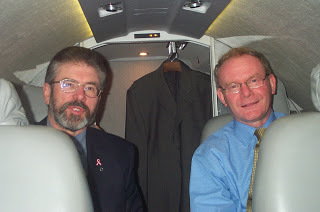
Mise agus Martin on a tiny plane
heading to another round of negotiations in 2003 I remember Martin McGuinness, in response to a question, telling a journalist that he expected to be dead before he was twenty five. I told the same journalist the same thing. That’s the way it was in the 1970s when Martin and I first met the British Government in an effort with others to negotiate a way to end the conflict. I was twenty three. Martin was about eighteen months younger than me. As it turned out we both lived well beyond the quarter of a century that both of us thought would be our life span.I assume it might be difficult for anyone who didn’t experience conflict to understand why we thought the way we did. It seems very melodramatic when it’s written down like that. But that’s the way it was. Hunted in our own place. On the run. Living on the edge. If there was not quite a queue of would be assassins - in and out of British uniform - there was certainly enough to justify our concerns. It was open season on republican activists. Not just for me or Martin. But many, many others as well. And for our opponents and enemies. Contemporaries from all sides. Including some who were doing their best with deadly intent to fulfil our expectation. Not that we wanted to die. Far from it. That’s one fact to emerge from the pandemic crisis. Few of us want to die. Or to see others die.The longer I live - the more I learn - the less I know. There are so many mysteries to and in our existence. That’s part of the joy of living. Martin would have been seventy on Saturday 23 of May. Last Saturday. He lived a very full life and he lived it well. There was a wonderful online celebration organised by The Martin McGuinness Peace Foundation (its available still at https://www.youtube.com/watch?v=Uc1L_ajK3UA)Well done to all involved. Commiserations again to Bernie and the entire McGuinness clann.Martin’s death, his wake and funeral touched many people. I’m sure others who had loved ones killed by the IRA don’t see it like that. Fair enough. They too deserve respect. Their loved ones had lives worth living. Worth celebrating by their friends and families. We all have grieved after folks we love. Not only people killed in the conflict. Parents and grandparents. Other family members. Mates. Neighbours. In Ireland we have a tradition, steeped in our values, of gathering around a bereaved family to give them comfort and support. Part Christian with elements of another older pagan world we celebrate the life which has ended. Unless of course the dearly departed is a young person of someone deemed to have died before their time or in tragic circumstances. We have all experienced the shock of that. Of death by violence. Death by suicide. Sudden death.And yet we get comfort from the prayers and sympathy and solidarity of those who support us. And the wake and funeral and burial or cremation service are the occasion to give expression to all this. It’s telling the bereaved that they are not on their own. We’re sorry for their troubles. Even though we go back to and get on with our own lives that coming together is important. Taking that time to visit, to pay our respects, is part of what we are.That’s one aspect of the terrible deaths from the Coronavirus that many find so distressful. People dying alone. Especially older people in care homes or other congregated settings. Restrictions on funerals. Yes it’s necessary and I support the restrictions but it’s heart rending. I have missed funerals myself since the lock down of people I know, friends, former prisoners. It must be much, much worse for family members.All these thoughts come together in this column as I reflect on these matters of life and death. The pandemic will pass. We don’t know when but pass it will. It will affect some of us more than others. Just as the conflict did. Some who survive will never recover fully from the loss of a loved one. Or the circumstances of their death. Just like in the conflict.
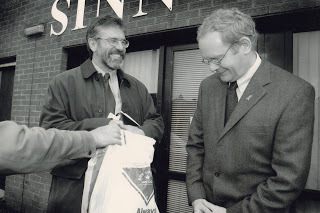 So Martin and I were the lucky ones. It’s still a wonder to me that he is gone and I’m still here. But that’s life. Our life begins every morning we wake up to a new day. So try to take the benefits of that with joy. Make the most of it. It won’t always be possible to see it like that. Not every day. But that’s okay also. It’s okay not to be okay. But try to be positive. Be alert to the wee things. The birdsong. The light in the sky. The kindness of friends. And strangers. A nice meal. A dance. A good tune. A dog. Flowers. The wind. A laugh. Companionship. Love. Children. Trees. A good walk. Friendship. Nature. A good book. A wee drink if you can handle it.Even if you don’t have any or all of these things you have yourself. That’s a big thing. Without yourself who or where would you be. So let’s try to be happy. Despite everything and because of everything. Remember we only die once. We live every day. Let’s do our best to be our best and to make this a better place for others less well off than we are.
So Martin and I were the lucky ones. It’s still a wonder to me that he is gone and I’m still here. But that’s life. Our life begins every morning we wake up to a new day. So try to take the benefits of that with joy. Make the most of it. It won’t always be possible to see it like that. Not every day. But that’s okay also. It’s okay not to be okay. But try to be positive. Be alert to the wee things. The birdsong. The light in the sky. The kindness of friends. And strangers. A nice meal. A dance. A good tune. A dog. Flowers. The wind. A laugh. Companionship. Love. Children. Trees. A good walk. Friendship. Nature. A good book. A wee drink if you can handle it.Even if you don’t have any or all of these things you have yourself. That’s a big thing. Without yourself who or where would you be. So let’s try to be happy. Despite everything and because of everything. Remember we only die once. We live every day. Let’s do our best to be our best and to make this a better place for others less well off than we are.
Published on May 30, 2020 06:03
May 22, 2020
BREAKING THEIR OWN LAWS.
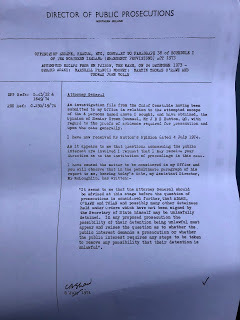 The British named it Operation Demetrius. For those of us who lived through the 9 August 1971 it was internment day. Like many others I was awakened early that morning by the sound of binlids rattling their alarm across the streets of Ballymurphy and Springhill. 342 men and boys from nationalist homes across the North were dragged from their beds in the early hours of the morning by thousands of British soldiers and RUC Many were beaten and 14 – the Hooded Men - were subjected to days of sustained torture.
The British named it Operation Demetrius. For those of us who lived through the 9 August 1971 it was internment day. Like many others I was awakened early that morning by the sound of binlids rattling their alarm across the streets of Ballymurphy and Springhill. 342 men and boys from nationalist homes across the North were dragged from their beds in the early hours of the morning by thousands of British soldiers and RUC Many were beaten and 14 – the Hooded Men - were subjected to days of sustained torture. Thousands fled their homes. 25 people were killed in the following four days. In my home area 11 local citizens, including a priest and mother of eight, were killed by the Paras in the Ballymurphy Massacre. Five months later the Paras attacked an anti-internment march in Derry and killed 14 people. Bloody Sunday was another of many dark days in the conflict. In July 1972 another five citizens, this time in Springhill, were killed by the British Army. They included another priest and a thirteen year old girl.
The Ulster Unionist Party, which for 50 years had ruled at Stormont, had demanded that the British bring in internment. It had been used in every decade since partition, including for a brief time in 1969. It was part of a repressive arsenal, including the Special Powers Act and institutionalised structured political and religious discrimination, which had sustained unionist domination in the North for 50 years. Internment of men and women was without charge or trail and for an indefinite undeclared period. Some of the older men had been interned many times. Liam Mulholland was first imprisoned in the 1920s and in every decade since including the 1970s. Throughout that time British governments supported the existence of this squalid little apartheid police state.
Of course, Unionism wasn’t alone in employing internment. It was used by the British after the 1916 Rising and again during the Tan War. The Free State government used it in the 1920s and Fianna Fáil brought it in between 1939 and 1946. Fianna Fáil used it again during the 1950s and in December 1970 the then Fianna Fáil Taoiseach Jack Lynch announced the introduction of internment but political and public outrage forced him to backtrack.
Whenever the British government went for the military option it brought with it the techniques of counter-insurgency that it had employed in dozens of colonial conflicts in Africa, Europe, the Middle East and Asia in the decades after the Second World War. These included the use of internment, the torture of detainees, shoot-to-kill tactics, curfew, riot control tactics, the use of state collusion and counter-gangs, and much more. Instead of asserting the primacy of politics the Conservative government of Prime Minister Ted Heath handed power over to the generals. The tactics and strategies that resulted from this failed to contain the conflict but instead led quickly to even greater resistance.
I was first arrested and interned in March 1972. After several days in Holywood Barracks where I was badly beaten I was taken to the Maidstone prison ship in Belfast Lough. The conditions for the 150 internees on the boat were appalling. We were held below deck. The fold-up bunks were in tiers of three. Light struggled in through small port-holes. The food was awful and the boat sat in its own sewage. The toilets were constantly flooded. Following protests by us the Maidstone was closed down by the British after Stormont was prorogued. We were all taken to Long Kesh by helicopter.In June 1972 I was released to take part in talks with the British government and then as part of a republican delegation to London. The truce that followed was short-lived.Just over a year later I was arrested again in July 1973. I was beaten unconscious by British soldiers and interned again in Long Kesh, initially under an Interim Custody Order. There are lots of photos of the Cages of Long Kesh available online if you want a sense of what it looked like. The camp was built on a former British RAF base. Every Cage was surrounded by a high wire fence topped with barbed wire. Each Cage had four Nissan huts made of two skins of corrugated tin. Cages held around 100 men and in the autumn and winter they were freezing cold, damp, and poorly lit. In the summer they could be stifling. Toilet and shower facilities were primitive. The food was normally cold and of a poor standard. Most internees relied on food parcels sent in by our families.
The British Army carried out periodic raids on the internee Cages. Scores of soldiers with batons and shields would smash their way into the huts during the night, drag men outside and force us to spread-eagle against the wire for hours. Many were beaten. Personal belongings were ripped apart, beds urinated on, and handicrafts – which some internees did to pass the time – were destroyed. Hugh Coney was shot dead in 1974.
Like prisoner-of-war camps throughout history there were also escapes – some successful – some less so. On Christmas Eve 1973 four of us in Cage 6 – Marshall Mooney, Tommy Toland, Marty O’Rawe and myself, all from Ballymurphy – tried to escape. We were caught.
Seven months later in July 1974 I was caught again. This time I managed to get a wee bit further. In March 1975 I was convicted on the first attempt and sentenced to 18 months imprisonment. I was subsequently convicted in April 1975 of the second attempt and was given a three year sentence to run consecutively.
Now that the British Supreme Court has ruled that my imprisonment was unlawful I would like to plead guilty to numerous other escape bids including some very scary claustrophobic efforts to dig tunnels. I was eventually released in 1977.
Fast forward 32 years and a researcher working for the Pat Finucane Centre in October 2009 was going through documents released by the British government under the 30 years rule. The researcher found a memorandum, dated 8 July 1974, from the Director of Public Prosecutions to the British Attorney General.
The key paragraph says: “It seems to me that the Attorney General should be advised at this stage before the question of prosecutions is considered further that Adams, O’Rawe and Tolan and possibility many other detainees held under the Orders which have not been signed by the Secretary of State himself may be unlawfully detained.”
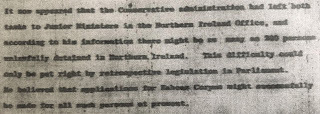 In the course of the ten years that it took from the researcher first uncovered this document to the British Supreme Court decision last week a further ‘Secret’ document was uncovered that revealed that the Labour Prime Minister Harold Wilson and his Secretary of State for the North Merlyn Rees held a meeting on the 17 July 1974 to discuss “an urgent problem” which the Attorney General had raised with him. The AG Samuel Silkin told Wilson and Rees that an examination of the papers concerning our attempted escape had revealed that the Interim Custody Orders of three of us had not been “examined personally by the Secretary of State during the Conservative administration”.
In the course of the ten years that it took from the researcher first uncovered this document to the British Supreme Court decision last week a further ‘Secret’ document was uncovered that revealed that the Labour Prime Minister Harold Wilson and his Secretary of State for the North Merlyn Rees held a meeting on the 17 July 1974 to discuss “an urgent problem” which the Attorney General had raised with him. The AG Samuel Silkin told Wilson and Rees that an examination of the papers concerning our attempted escape had revealed that the Interim Custody Orders of three of us had not been “examined personally by the Secretary of State during the Conservative administration”. Silkin told the meeting that there “might be as many as 200 persons unlawfully detained” in the North. This “could only be put right by retrospective legislation in Parliament.”
So, the British government knew, before it chose to put me on trial, that I was unlawfully detained. It also knew that up to 200 other people might also be unlawfully interned. It did nothing. The onus is now on the British government to identify and inform other internees whose Internment may also have been unlawful. That’s unlikely so if you were arrested and interned between 7 November 1972 and early 1974 and you think that your internment order was unlawful don’t wait - contact your solicitor.
Published on May 22, 2020 09:00
May 15, 2020
The Choctaws- A Debt Repaid.
The Irish proverb: “Is ar scáth a chéile a mhaireann na daoine.” translates as: “We all live in each other’s shadow.” In other words we are all interlinked.In our own lifetime probably no greater example of this connectivity between people and communities – of us living in each other’s shadow - is to be found in the communal response to the Coronavirus pandemic. Frontline health workers, carers, shop workers, lorry drivers and so many others have minded us despite the risk to themselves. Community activists have again and again collected and delivered much needed food parcels and prepared hot food for those in need. While this is a universal response and not uniquely Irish it is also in keeping with one of our traditions. That is the meitheal, when neighbours come together to help with the harvest or turf but also following misfortune.There are many examples of this in recent times and thankfully lots of evidence that the spirit of the meitheal – a sense of community, solidarity and volunteerism is alive and well among our people.This empathy and compassion helps connect us. We are able to look beyond our own individual concerns, desires and fears and reach out to assist others in our family, our street, our community or our world.One recent example of this was last Friday night’s The Late Late Show on RTE. At a time when so many are experiencing huge stress in their lives viewers of The Late Late Show raised over two million euro for Pieta House, the largely voluntary organisation which provides free therapy to those engaging in self-harm, with suicidal ideation, or bereaved by suicide. It was an amazing example of generosity.Last September the GoFundMe organisation revealed that the Irish people are the most generous in the world. GoFundMe said that nearly one in ten Irish men and women have donated over 40 million euro to GoFundMe causes in the last ten years. There have been 860,000 individual donations. Organisations like St. Vincent de Paul, as well as Trocaire and Concern are among many that also raise millions each year to help those here and overseas who need support – health care, food, water, shelter.Why are the Irish so generous? While we are no better than anyone else, essentially we are decent people. Loving. Compassionate. Caring. But we are also a people who have historically experienced conquest and occupation, colonisation and migration. It’s in our DNA. Even if we are not fully aware of our own history it does give us an empathy with the difficulties faced by others. This includes developing nations still suffering from the impact of colonisation, migration, exploitation and conflict.The most devastating upheaval in Irish history was An Gorta Mór - The Great Hunger. The census of 1841 estimated that the population of our island was just above eight million. Over 6 million were tied in a desperate battle with the land to produce enough for their families to live on. Most had less than a half-acre plot of land. They were totally dependent on the potato. The British government understood the dangers of the overreliance on the potato. During the first four decades of the 19th century there were at least 150 committees and commissions of enquiry which reported on the danger of famine. They were ignored.The failure of the potato crop in 1845 led to even greater hardship. One effect of this was to force people to flee overseas. They abandoned their mostly one roomed, mud or turf-walled cabins, with their sod roofs, and their small parcels of land. They left on ships (many of which had carried African slaves a few decades earlier) bound for North America. Coffin ships!In the five years of The Great Hunger it is estimated that one million died and another million fled. By the end of the 19th century there were more Irish people living abroad than on the island of Ireland. The Great Hunger -An Gorta Mor- left an indelible mark on the Irish psyche. In my opinion it has shaped and made us more empathetic to the experience of other peoplesOne account from An Gorta Mór which has been told and retold many times over the years is the help given to the starving Irish by the Choctaw native American people in Oklahoma.The Choctaw nation was originally from the Mississippi region in the USA. In 1830 15,000 people were forced to walk 600 miles away to Oklahoma. In what subsequently came to be known as the ‘Trail of Tears’ a quarter of them died. Even when they reached their new place they were destitute and faced violence and intimidation. One Choctaw man described how their homes were “torn down and burned, our fences destroyed, cattle turned into our fields, and we ourselves have been scourged, manacled, fettered, and otherwise personally abused, until by such treatment some of our best men have died.”Despite the many dangers and challenges they faced in their own lives the Choctaw people were moved by the accounts in local papers of the great hunger in Ireland. One historian, Anelise Hanson Shrout writing in the Journal of the Early Republic described the plight of the Choctaw people: “Most would have experienced enormous financial, emotional, and demographic damage as a result of removal. It is difficult to imagine a people less well-positioned to act philanthropically.” But act they did. At a meeting they managed to raise $170 – about $5,000 today. That act of kindness and generosity has never been forgotten.Consequently, several weeks ago when a GoFundMe page was opened to raise money for the Navajo and Hopi peoples trying to combat Covid-19 many Irish people donated to that effort and cited the help given by the Choctaw almost two hundred years ago as a reason for this. It is an act of solidarity by people in Ireland to native peoples in Arizona, New Mexico and Utah who are reeling under the impact of Civid-19. Gary Batton, chief of the Choctaw Nation of Oklahoma, said last week that the tribe was “gratified — and perhaps not at all surprised — to learn of the assistance our special friends, the Irish, are giving to the Navajo and Hopi Nations.”So, one act of generosity, of solidarity 173 years ago is being reciprocated today by another act of solidarity. Is ar scáth a chéile a mhaireann na daoine.
Published on May 15, 2020 03:45
May 8, 2020
Remembering Bobby Sands.
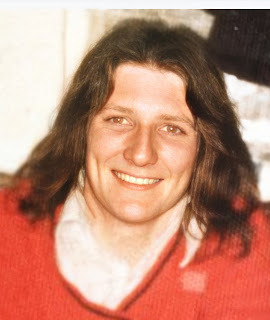 In 1973 just before midnight on Christmas Eve, I was caught along with three other comrades attempting to escape from Long Kesh. We were among a large group of men and women interned without charge or trial. My first bout of internment was on the Maidstone Prison Ship in 1972. Internees-the British later called us detainees as part of their fiction that internment was ended – were held in Armagh Women’s Gaol, Belfast Prison, Magilligan, and Long Kesh.
In 1973 just before midnight on Christmas Eve, I was caught along with three other comrades attempting to escape from Long Kesh. We were among a large group of men and women interned without charge or trial. My first bout of internment was on the Maidstone Prison Ship in 1972. Internees-the British later called us detainees as part of their fiction that internment was ended – were held in Armagh Women’s Gaol, Belfast Prison, Magilligan, and Long Kesh.In July 1974 I was caught again in another escape bid. Steve McQueen I was not. The following March 1975 I was taken out to court where I was convicted on the first escape attempt and received an 18 month sentence. A month later I was convicted of the second escape attempt and got another three years.Then as the rest of the internees were being released a small group of us nearly got-aways were moved out of the internee end of Long Kesh to the top end of the camp where the sentenced POWs were held. We were incarcerated in Cage 11. None of us had the benefit of trial by a jury of our peers. The British judicial system had dispensed with that in favour of non jury courts with special rules. It was the same in the South.
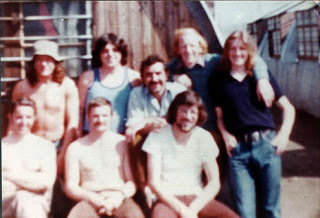 I met Bobby Sands in Cage 11 of Long Kesh. I don’t remember exactly the first time we met but it was almost certainly at one of the discussion groups I set up for those who were interested. There were around eighty of us in Cage 11. For those of you who don’t know about the Cages that’s exactly what they were. We were caged into a compound surrounded by a high wire fence in which there were four Nissan huts, a study hut and a toilet shower hut. At one time there were twenty two cages. In Cage 11 one of the Nissan huts was also a Gaeltacht which was set up by some prisoners for those wanting to learn the Irish language. That’s where Bobby was.
I met Bobby Sands in Cage 11 of Long Kesh. I don’t remember exactly the first time we met but it was almost certainly at one of the discussion groups I set up for those who were interested. There were around eighty of us in Cage 11. For those of you who don’t know about the Cages that’s exactly what they were. We were caged into a compound surrounded by a high wire fence in which there were four Nissan huts, a study hut and a toilet shower hut. At one time there were twenty two cages. In Cage 11 one of the Nissan huts was also a Gaeltacht which was set up by some prisoners for those wanting to learn the Irish language. That’s where Bobby was.
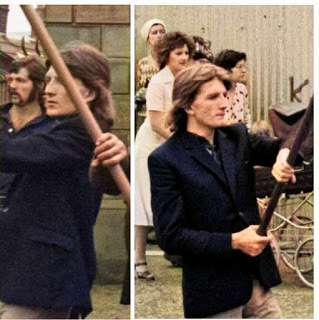 He was keenly interested in our discussions. We went on to get books from old Joe Clarkes Book Bureau in Dublin and from The Connolly Association in London. As political books were banned our friends outside used to put other book covers on them. I still have Desmond Greaves brilliant book on Liam Mellows disguised as something less dangerous. Bobby was a voracious reader.I remember him also as a keen sportsman who played soccer or Gaelic football whenever he got the chance. He had long hair, a good sense of humour and liked music. He was very good on the guitar. I remember the two of us sitting in the study hut – in reality a wooden shed. I would be writing while Bobby would be practicing on his guitar.His party piece was the classic by Kris Kristofferson, ‘Me and Bobby McGee’ and later when he went to the H Blocks Bobby wrote songs including ‘McIlhatton’ and ‘Back home in Derry’. They were famously recorded by Christy Moore and are now part of the tradition. Bobby would be immensely proud of that.On one memorable Christmas Eve we held a concert to mark the occasion. There was a bar, from which a group of comrades served beer, cider and poteen they had brewed up illicitly for the occasion. In the course of the concert Bobby and Martin McAllister played some lovely sets.The finale and highlight of the night consisted of a bunch of prisoners including Bobby and Danny Lennon suitably bewigged and costumed miming Queen’s ‘A Night At the Opera’.I got to know Bobby well during our political debates and lectures. Bobby was a very intelligent, committed republican. He enjoyed political discussions and he was very open to new ideas. He made up his own mind. Many of our discussions focussed on the need to convert passive support for our struggle into active support and of the need for the primacy of politics and for clear strategies and democratic structures to implement these strategies. It was at this time that Bobby picked up on the concept of everyone having a role in the struggle, no matter how small.
He was keenly interested in our discussions. We went on to get books from old Joe Clarkes Book Bureau in Dublin and from The Connolly Association in London. As political books were banned our friends outside used to put other book covers on them. I still have Desmond Greaves brilliant book on Liam Mellows disguised as something less dangerous. Bobby was a voracious reader.I remember him also as a keen sportsman who played soccer or Gaelic football whenever he got the chance. He had long hair, a good sense of humour and liked music. He was very good on the guitar. I remember the two of us sitting in the study hut – in reality a wooden shed. I would be writing while Bobby would be practicing on his guitar.His party piece was the classic by Kris Kristofferson, ‘Me and Bobby McGee’ and later when he went to the H Blocks Bobby wrote songs including ‘McIlhatton’ and ‘Back home in Derry’. They were famously recorded by Christy Moore and are now part of the tradition. Bobby would be immensely proud of that.On one memorable Christmas Eve we held a concert to mark the occasion. There was a bar, from which a group of comrades served beer, cider and poteen they had brewed up illicitly for the occasion. In the course of the concert Bobby and Martin McAllister played some lovely sets.The finale and highlight of the night consisted of a bunch of prisoners including Bobby and Danny Lennon suitably bewigged and costumed miming Queen’s ‘A Night At the Opera’.I got to know Bobby well during our political debates and lectures. Bobby was a very intelligent, committed republican. He enjoyed political discussions and he was very open to new ideas. He made up his own mind. Many of our discussions focussed on the need to convert passive support for our struggle into active support and of the need for the primacy of politics and for clear strategies and democratic structures to implement these strategies. It was at this time that Bobby picked up on the concept of everyone having a role in the struggle, no matter how small.
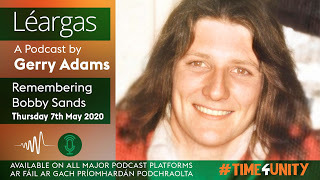 He was also an internationalist. He read about other struggles, in particular the struggle against apartheid in South Africa and the efforts of the Palestinian peoples to achieve a homeland. Four decades later South Africa has been transformed, largely by a generation of activists who were in apartheid prisons at the same time that Bobby and we were in British prisons.On my first visit to South Africa in 1995 we were hosted by the ANC Executive. Walter Sisulu, who had spent over 25 years on Robben island and had just turned 83, made a special point of coming to the lunch. He spoke of his own time in prison and of his memories of the hunger strike in Ireland in 1981. He told us of the great solidarity that existed between ANC prisoners and the republican prisoners. It was an emotional speech in which he recalled hearing of the death of Bobby Sands and of the silent tribute ANC prisoners across South Africa paid to a fellow freedom fighter.Nelson Mandela was on Robben Island when Bobby died. In his cell, in common with all political prisoners, he was allowed as a privilege a calendar on which he marked significant events. On the 5th May 1981 a simple single line is written: ‘IRA martyr Bobby Sands dies.’ A tribute, hand written, on a paper calendar on a cell wall in South Africa which recognises the bond of those who struggle for justice.Of course none of us in Cage 11 forsaw any of this For a small group with release dates pending our concern was about how we could transfer some of our ideas to the outside. I remember in the weeks before his release Bobby seeking me out to walk around the yard –‘boowling’ in prison parlance as we swapped political ideas and concepts.Bobby was released from Cage 11 in early 1976. He reported back to the IRA in Twinbrook. Here he set about promoting ideas for local activists acting in solidarity with their communities. He became very involved in local housing actions including the Twinbrook Tenants Association. In August that year the annual republican march, which had previously focussed on ending internment, was now about raising awareness of the British moves to end political status and to criminalise the POWs and through them the republican struggle. It was the first big march in support of political status and was addressed by Máire Drumm. Bobby was part of the Colour Party and the photographs which were found last year of him participating in the event reveal a very young man, with short hair. Just weeks later he was imprisoned again.Like hundreds of men and women Bobby was denied political status and joined the prison protests which were now taking place in the H Blocks and in Armagh Women’s Prisons. Naked, but for a blanket, and living under the most brutal and violent of prison regimes, Bobby was driven to write about the conditions in the H-Blocks. They provide an insight into a spirit that refused to be broken.
He was also an internationalist. He read about other struggles, in particular the struggle against apartheid in South Africa and the efforts of the Palestinian peoples to achieve a homeland. Four decades later South Africa has been transformed, largely by a generation of activists who were in apartheid prisons at the same time that Bobby and we were in British prisons.On my first visit to South Africa in 1995 we were hosted by the ANC Executive. Walter Sisulu, who had spent over 25 years on Robben island and had just turned 83, made a special point of coming to the lunch. He spoke of his own time in prison and of his memories of the hunger strike in Ireland in 1981. He told us of the great solidarity that existed between ANC prisoners and the republican prisoners. It was an emotional speech in which he recalled hearing of the death of Bobby Sands and of the silent tribute ANC prisoners across South Africa paid to a fellow freedom fighter.Nelson Mandela was on Robben Island when Bobby died. In his cell, in common with all political prisoners, he was allowed as a privilege a calendar on which he marked significant events. On the 5th May 1981 a simple single line is written: ‘IRA martyr Bobby Sands dies.’ A tribute, hand written, on a paper calendar on a cell wall in South Africa which recognises the bond of those who struggle for justice.Of course none of us in Cage 11 forsaw any of this For a small group with release dates pending our concern was about how we could transfer some of our ideas to the outside. I remember in the weeks before his release Bobby seeking me out to walk around the yard –‘boowling’ in prison parlance as we swapped political ideas and concepts.Bobby was released from Cage 11 in early 1976. He reported back to the IRA in Twinbrook. Here he set about promoting ideas for local activists acting in solidarity with their communities. He became very involved in local housing actions including the Twinbrook Tenants Association. In August that year the annual republican march, which had previously focussed on ending internment, was now about raising awareness of the British moves to end political status and to criminalise the POWs and through them the republican struggle. It was the first big march in support of political status and was addressed by Máire Drumm. Bobby was part of the Colour Party and the photographs which were found last year of him participating in the event reveal a very young man, with short hair. Just weeks later he was imprisoned again.Like hundreds of men and women Bobby was denied political status and joined the prison protests which were now taking place in the H Blocks and in Armagh Women’s Prisons. Naked, but for a blanket, and living under the most brutal and violent of prison regimes, Bobby was driven to write about the conditions in the H-Blocks. They provide an insight into a spirit that refused to be broken.
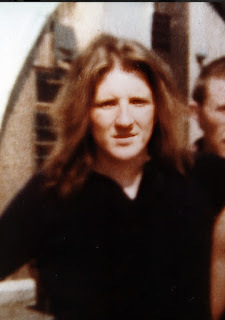 Bobby’s smuggled comms- letters; poems; articles; creative pieces; and stories - written on scraps of torn bible pages or cigarette papers using the infill of a biro, and all wrapped in cling film and hidden in his naked body, tell you more about the brutal reality of life for political prisoners and the nature of British rule in the northern state than anything else I can think of. These are not the invented musings or a plot device of a clever writer. They are the daily experiences of hundreds of men and women over five terrible years.When he died on 5 May 1981 Bobby had spent one third of his 27 years in prisons. He was never interviewed on television or radio, though while on hunger strike two journalists briefly saw him for half an hour. We only have a few photographs of him. And yet his name is known and honoured around the world. His writings tell us much about the man. I like in particular his poem the Rhythm of Time. But for this occasion I think it appropriate that we read his own account of one day in his life in the H-Blocks and imagine the courage and strength of character that allowed Bobby and Francie, Raymond, Patsy, Joe, Martin, Kevin, Kieran. Tom and Mickey to put their lives on the line for their comrades and for the Irish cause. In this anniversary week of his death here is Bobby Sands in his own words. I am blessed to have known him and his comrades.
Bobby’s smuggled comms- letters; poems; articles; creative pieces; and stories - written on scraps of torn bible pages or cigarette papers using the infill of a biro, and all wrapped in cling film and hidden in his naked body, tell you more about the brutal reality of life for political prisoners and the nature of British rule in the northern state than anything else I can think of. These are not the invented musings or a plot device of a clever writer. They are the daily experiences of hundreds of men and women over five terrible years.When he died on 5 May 1981 Bobby had spent one third of his 27 years in prisons. He was never interviewed on television or radio, though while on hunger strike two journalists briefly saw him for half an hour. We only have a few photographs of him. And yet his name is known and honoured around the world. His writings tell us much about the man. I like in particular his poem the Rhythm of Time. But for this occasion I think it appropriate that we read his own account of one day in his life in the H-Blocks and imagine the courage and strength of character that allowed Bobby and Francie, Raymond, Patsy, Joe, Martin, Kevin, Kieran. Tom and Mickey to put their lives on the line for their comrades and for the Irish cause. In this anniversary week of his death here is Bobby Sands in his own words. I am blessed to have known him and his comrades.
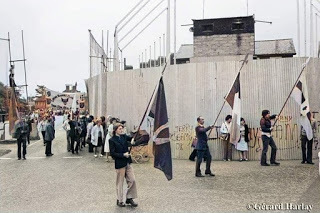 One Day in My Life:“I mumbled a “Hail Mary” to myself and a hurried “Act of Contrition” as I heard the approaching jingle of keys. Several gloved hands gripped and tightened around my arms and feet, raising my body off the ground and swinging me backwards in the one movement. The full weight of my body recoiled forwarded again, smashing me head against the corrugated iron covering around the gate. The sky seemed to fall upon me as they dropped me to the ground. …Every part of me stung unmercifully as the heavily disinfected water attacked my naked, raw flesh. I made an immediate and brave attempt to rise out of the freezing, stinging water but the screws held me down while one of them began to scrub my already tattered back with a heavy scrubbing brush. I shrivelled with the pain and struggled for release but the more I fought the more they strengthened their iron grip …They continued to scrub every part of my tortured body, pouring buckets of ice-cold water and soapy liquid over me. I vaguely remember being lifted out of the cold water – the sadistic screw had grabbed my testicles and scrubbed my private parts. That was the last thing I remembered. I collapsed…It was cold, so very, very cold. I rolled on to my side and placed my little treasured piece of tobacco under the mattress and felt the dampness clinging to my feet.That’s another day nearer to victory. I thought feeling very hungry. I was a skeleton compared to what I used to be but it didn’t matter. Nothing really mattered except remaining unbroken. I rolled over once against, the cold biting at me. They have nothing in their entire imperial arsenal to break the spirit of one single Republican political prisoner-of-war who refuses to be broken. I thought, and that was very true. They cannot or never will break our spirit. I rolled over again freezing and the snow came in thew window on top of my blankets. “Tiocfaidh ár lá,” I said to myself. “Tiocfaidh ar lá.”
One Day in My Life:“I mumbled a “Hail Mary” to myself and a hurried “Act of Contrition” as I heard the approaching jingle of keys. Several gloved hands gripped and tightened around my arms and feet, raising my body off the ground and swinging me backwards in the one movement. The full weight of my body recoiled forwarded again, smashing me head against the corrugated iron covering around the gate. The sky seemed to fall upon me as they dropped me to the ground. …Every part of me stung unmercifully as the heavily disinfected water attacked my naked, raw flesh. I made an immediate and brave attempt to rise out of the freezing, stinging water but the screws held me down while one of them began to scrub my already tattered back with a heavy scrubbing brush. I shrivelled with the pain and struggled for release but the more I fought the more they strengthened their iron grip …They continued to scrub every part of my tortured body, pouring buckets of ice-cold water and soapy liquid over me. I vaguely remember being lifted out of the cold water – the sadistic screw had grabbed my testicles and scrubbed my private parts. That was the last thing I remembered. I collapsed…It was cold, so very, very cold. I rolled on to my side and placed my little treasured piece of tobacco under the mattress and felt the dampness clinging to my feet.That’s another day nearer to victory. I thought feeling very hungry. I was a skeleton compared to what I used to be but it didn’t matter. Nothing really mattered except remaining unbroken. I rolled over once against, the cold biting at me. They have nothing in their entire imperial arsenal to break the spirit of one single Republican political prisoner-of-war who refuses to be broken. I thought, and that was very true. They cannot or never will break our spirit. I rolled over again freezing and the snow came in thew window on top of my blankets. “Tiocfaidh ár lá,” I said to myself. “Tiocfaidh ar lá.”
Published on May 08, 2020 07:27
May 1, 2020
Solidarity is saving lives.
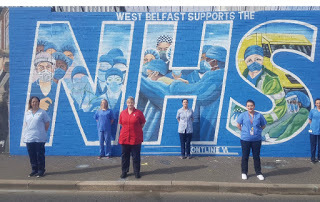
There is a lot of speculation about when the lockdown caused by the pandemic will end. As a lay person my own best call is that it will be some time before we should do this. The main factor in any decision to relax confinement measures has to be the health needs of citizens. Without a vaccine the Coronavirus remains a terrible threat to our well being and to the most vulnerable amongst us.
The pandemic is far from over, and its significant economic consequences, allied to those of Brexit, are still to be felt.
Some commendable and welcome investigative reports by journalists and media platforms have begun to shine a light on the confusion, lack of planning, irresponsible decisions, public utterances, neglect, and disregard for the lives and welfare of their citizens that has marked the response of some governments and government agencies to this global threat.
The absence of political leadership in Britain in the early stages of the crisis, including the failure of its Prime Minister Boris Johnson to attend the critical February meetings of its Cobra co-ordinating committee, have all been highlighted. So too has the adherence by some unionist leaders to the British strategy, even when it was clear that that strategy was at odds with the recommendations of the World Health Organisation.
The failure by the British and Irish governments to respond speedily to protect our elderly and most vulnerable citizens, especially in nursing and care homes, and others potentially in other congregated settings is already attracting significant criticism. There was also the widespread lack of guidelines and Personal Protection Equipment for front line staff in hospitals, nursing and care homes and for those involved in keeping our food and essential services open.
Some commentators are trying to excuse governments for not being as prepared as they should have been. But the fact is that the threat of pandemics has been known for a very long time. In the last two decades there was SARS (severe acute respiratory syndrome) in 2002-4, then the H1N1 influenza in 2009, and in 2012-14 there was the worst outbreak to date of the Ebola virus which killed over two thousand people.
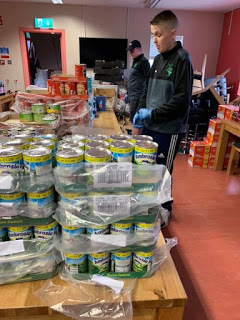 Last September, four months before the Wuhan outbreak, the Global Preparedness Monitoring Board published its report – A World at Risk – which examined the world’s preparedness for global health emergencies on the back of the outbreaks of the last 20 years.
Last September, four months before the Wuhan outbreak, the Global Preparedness Monitoring Board published its report – A World at Risk – which examined the world’s preparedness for global health emergencies on the back of the outbreaks of the last 20 years.In their foreword the organisation’s Co-Chairs H.E. Dr Gro Harlem Brundtland, a former Director General of the World Health Organisation and Mr Elhadj As Sy, the Secretary General of the International Federation of Red Cross and red Crescent Federations, reviewed recommendations from previous high-level panels and commissions. They wrote: “.....there is a very real threat of a rapidly moving highly lethal pandemic of a respiratory pathogen killing 50 to 80 million people and wiping out nearly 5% of the world’s economy. A global pandemic on that scale would be catastrophic, creating widespread havoc, instability and insecurity. The world is not ready.”
On 30 January the World Health Organisation declared the Coronavirus outbreak a “a global emergency”. Yet on the same day the Irish Times reported that: “The risk of Coronavirus cases occurring here remains moderate and Ireland is well prepared for any outbreak, according to the Health Service Executive... “You are extremely unlikely to catch novel Coronavirus from someone in Ireland,” Joe Ryan, HSE national director of services, told a briefing on Thursday. While there have been 10 confirmed cases in the EU, the likelihood of further cases being brought into Europe is moderate, he said.”
Within weeks the South’s Health Service, undermined by successive Fianna Fáil and Fine Gael governments, including a recruitment embargo, and by the austerity policies of Fine Gael led governments from 2011, found itself confronted by a huge challenge. It was not properly prepared for or equipped to deal with the health crisis which emerged.
In Britain a Sunday Times report two weeks ago quoted an adviser to Downing Street saying that while Britain had at one time listed a possible pandemic as the No 1 threat; “pandemic planning became a casualty of the austerity years when there were more pressing needs.” The source said preparations for a no-deal Brexit “sucked all the blood out of pandemic planning” in the following years”.
There are already calls for a public enquiry into how the British government responded. There may be a need also on this island for similar investigations.
In the meantime our frontline workers continue to put themselves in danger as they care for those affected by Covid-19. Last Thursday I once again joined the public show of solidarity for NHS staff. The applause is heartfelt. Our admiration for our doctors and nurses and hospital ancillary staff is sincere.
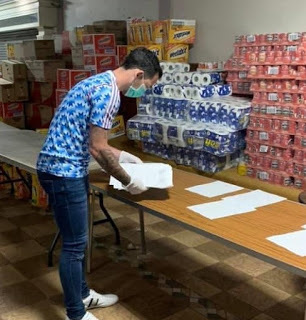 Community solidarity has been one of the great positives to come out of this crisis. Shop staff, those who stack the shelves in food stores, care staff in nursing homes, lorry drivers, taxi drivers, postal workers, delivery drivers, those working in garages, pharmacies, and making and delivering food, and many others have made it possible for those of us who are in lock-down to put food on our tables, heat our homes, and receive essential services. Most of these workers are in precarious employment – among the lowest paid– but now they are the rock upon which our society functions.
Community solidarity has been one of the great positives to come out of this crisis. Shop staff, those who stack the shelves in food stores, care staff in nursing homes, lorry drivers, taxi drivers, postal workers, delivery drivers, those working in garages, pharmacies, and making and delivering food, and many others have made it possible for those of us who are in lock-down to put food on our tables, heat our homes, and receive essential services. Most of these workers are in precarious employment – among the lowest paid– but now they are the rock upon which our society functions.At the same time community and voluntary groups and neighbours have ensured that food parcels and where practical hot food, is delivered to those in need. Across Ireland community and Church halls, GAA facilities, other sporting and social clubs and Orange halls, volunteer workers have come together to help. Theirs is the true spirit of community and volunteerism. Without their selfless efforts many of our most vulnerable citizens would fall through the cracks of a system which was already deeply flawed and which is stretched to breaking point.
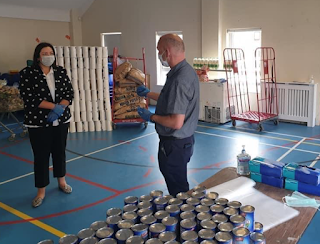 Minister Deirdre Hargey MLA and Paul Maskey MP
Minister Deirdre Hargey MLA and Paul Maskey MPThat concern for others is at the core of a community solidarity and leadership which is saving lives.
So, let’s continue to be careful. No rushing to end the protections which have helped so far to protect citizens. Let us also give some thought to the future. Some commentators are talking about the need to get back to normal. Normal? What we had before the pandemic wasn’t normal. What we need is change. Big bold societal change. One lesson that is now patently obvious is that the initial failure to adopt an all-island strategy to confront Covid-19 was a mistake.
Under the current ‘Foot and Mouth Disease Control Strategy’ for the North which was revised in 2016 the six counties is “recognised as a separate epidemiological unit from the rest of the UK and would liaise with the Republic of Ireland during an outbreak of FMD in either or both jurisdictions. It is recognised by the Department of Agriculture, Environment and Rural Affairs (DAERA) and the Department of Agriculture, Food and Marine (DAFM) that sustained co-operation between both administrations would be essential to reduce the further spread of FMD”.
It appears we can have an all-island strategy for protecting animal health but not human health. This is a stupid and irresponsible position and underlines the desirability of creating an all-island health service. This must be one of our goals in the time ahead. It is needed even more now.
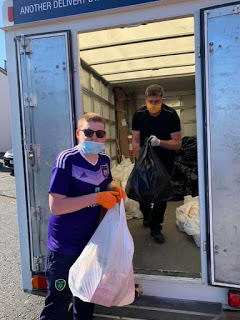
Published on May 01, 2020 04:17
April 24, 2020
Martin and Varadkar toxic twins of austerity
I hope you are all staying safe and well. My thoughts are with those who are sick and with their relatives, and with those who have suffered bereavement. Welcome back to our leader Mary Lou who was down with Covid-19.Notwithstanding the primacy and priority that the pandemic deserves, not least because of the deaths and distress it is causing I want to return to the need for a Government for Change in Dublin. In fact the pandemic and the recovery from it requires such a government.
In the days before the February General Election I described that election as part of the necessary process of the realignment of politics on the island of Ireland. I also remarked that this process has been slow and hesitant at times but that if republicans do our work well – think strategically, organise, be energetic and rooted, never give up and stay focused on the future, that a tipping point can emerge – a space in which significant and historic change is possible. I said: “This election looks like being such an event.”
It was. Although few - me included - foresaw the strength of the surge in the republican vote.
Sinn Féin won the popular vote and set about trying to put in place a government for change with those like-minded parties and individual TDs who had campaigned for change. That work is ongoing. The options are limited but it’s a long game and it’s not over until it’s over.
Fianna Fáil and Fine Gael insist that they will not talk to Sinn Féin about government formation. Just like the Unionist used to do. It is deeply insulting, and totally unacceptable for anyone to disrespect and refuse to accept all voters as legitimate citizens whose votes are equal to every other vote. The support for this anti-democratic posture by sections of the media is also reprehensible. Shame on them all.
The establishment were flummoxed when Sinn Fein won the popular vote and emerged, following the election of An Ceann Chomairle, with the same number of elected TDs as Fianna Fáil and more than Fine Gael. For the first time ever, Fianna Fáil and Fine Gael took less than 50% of the vote.
Micheál Martin who was behaving like An Taoiseach-In-Waiting, was shell shocked. Large sections of the electorate were clearly opting for change. Mr Martin was not one of them. Like Mr Varadkar his vision is conservative and confined by and large to preserving the status quo in the southern state. A consequence in part, of a hundred years of partition allied to a desire to hold on to power.
Both he and Leo Varadkar repeatedly rubbished any suggestion that they might enter coalition together. Micheál Martin said in January that “any government involving Fine Gael is not change.” He later said: “we will not be entering into a grand coalition … the people want change … they want Fine Gael out of office … they’ve been there too long … they haven’t delivered on the key issues of housing and health and the impact of the costs living.” He described any u-turn on a coalition with Fine Gael as “Jekyll and Hyde behaviour “.
Fianna Fáil and Fine Gael have been election rivals for almost 100 years. The two parties emerged out of the violence and chaos of the Civil War. Cumann na nGaedheal governed the Irish Free State – established under partition - until 1932. It lost the general election that year to Fianna Fáil which had split from Sinn Féin in 1926. In 1933, Cumann na nGaedheal merged with the right wing National Centre Party and the fascist Blueshirts to form Fine Gael.
Fianna Fáil posed as the anti-Treaty Republican Party. Fine Gael was the pro-Treaty party. Each was and is conservative and their economic record and policies reflect this. Fianna Fáil had a more populist approach which attracted a greater number of working class votes.
From 1932 every government formed in the South had either Fianna Fáil or Fine Gael at their heart, often attracting over 70% of the votes. During this time they did very little to tackle the festering sore of discrimination in the North or any of the other evils of partition. Or the inequalities in their own state.
However in the 2016 general election this cosy arrangement of alternating power between these two parties began to falter. Fianna Fáil was the party largely responsible for the economic crash in 2008 and the subsequent horrendous deal with the Troika which handcuffed citizens for decades to come to a €50 billion banking debt. Hundreds of thousands lost their jobs and many families saw sons and daughters emigrating to find employment. When Fianna Fáil was kicked out of office in 2011 Fine Gael and Labour ruthlessly implemented austerity policies that imposed huge hardship on citizens and cut public services to the bone, especially in the provision of housing and in the health service.
Little wonder the government had to scramble to shore up these depleted services in the face of the pandemic. As always the people, particularly health workers and other frontline workers, responded with great courage and willingness to help out those most at risk. Solidarity, community, fairness and decency were and remain the core values embraced by most citizens.
The logic of the two conservative parties merging has long been mooted as a logical outcome of the sameness of their policies and politics. Following the 2016 general election, there was intense speculation and debate once again around this possibility. Micheál Martin was explicit: “… the best interests of the Irish people are not served by a government made up of Fianna Fáil and Fine Gael. We made it very clear to the Irish people and those voting for us that we would not go into government with Fine Gael and we’re remaining consistent and true to that commitment.”
They came up with the next best option to serve their selfish self-interest – the confidence and supply agreement. For four years Fianna Fáil kept Fine Gael in power while pretending that they weren’t really in partnership and culpable for the crises in housing, homelessness and health. But this time the electorate were not fooled.
Then the awful pandemic kicked in and understandably the issue of government formation receded in public consciousness as we all came to terms with this dreadful plague.
Fianna Fáil and Fine Gael have now produced their Framework document. Its grandiose title is “A draft documents between Fianna Fáil and Fine Gael to facilitate negotiations with other parties on a plan to recover, rebuild and renew Ireland after the Covid-19 Emergency.”
As Pearse Doherty has pointed out if Sinn Féin had published this document we would have been ridiculed, quite rightly, by the establishment media. It is dishonest, full of vague generalizations and aspirations, with no specific plans, timetables, targets, costings or policy detail. It’s a wish list with no substance.
Its primary aim is to keep Sinn Fein out of government and put Fianna Fáil and Fine Gael in government. It cannot deliver the kind of change that the majority of citizens in the South voted for in February. Why should citizens, or the smaller parties and independents being courted by them, trust Fianna Fáil and Fine Gael? These parties are responsible for the very crises they now claim they want to end.
Their only firm economic commitment is that a FFFG government will comply with the strict conservative European fiscal rules. That can only mean a further squeeze on public services. Surely one of the big lessons of the pandemic crisis is the need, and the entitlement of citizens, to health care, childcare and eldercare as a right. Surely that’s the least the State should do in the common good. That means challenging the EU rules, not blindly complying with them.
The looming economic crisis resulting from Covid-19 also highlights the common sense need for the island of Ireland to confront these significant economic challenges on an all-Ireland basis. Our ability to co-ordinate and maximise our economic response, transform our healthcare services, protect our agricultural and agri-food sector and produce an effective climate change policy to meet the climate emergency, would all be more effective in an all-island context.
The approach of the British government has been disastrous. Boris Johnson is a disgrace. It makes no sense for anyone in Ireland to follow his policies, such as they are. It makes sense to have an all-Ireland approach to Covid 19 – that is what Mary Lou and Michelle O Neill and Sinn Féin’s Ministerial team have been pushing. We have had an all island approach for animal health. We need an all island approach for human health. We have a huge advantage as an island nation and as we exit this pandemic this is critical.
In the section of their Agreement entitled ‘Mission: A Shared Island’, Fianna Fáil the so-called ‘Republican Party’ and Fine Gael the so-called ‘United Ireland’ party, couldn’t bring themselves to even use the term ‘United Ireland’. Their ‘Shared Ireland’ section contains nothing new. The commitment to establish a “Unit within the Department of An Taoiseach to work towards a consensus on a united island” is a lift from Fianna Fáil’s 2020 Election Manifesto in January. It falls short of what is required to plan for the future. What now of Simon Coveney’s assertion: "I would like to see a united Ireland in my lifetime – if possible, in my political lifetime.”
I wonder did he bother putting this forward? Or did Michéal Martin knock him back? Leo Varadkar has similar lines on unity. Did he put forward any of these? 0r the proposals coming from civic society North and South which he received in a letter last November calling for the setting up of a “Citizens Assembly reflecting the views of citizens North and South, or a Forum to discuss the future and achieve maximum consensus on a way forward.” If he didn’t, why not?
And what of Micheál Martin’s promise that FF would ‘soon’ produce a white paper on Unity. That was nine years ago. Three years ago he promised a 12 point plan of ‘concrete proposals’ on unity. No sign of that in the new Agreement. Or anywhere else.
The truth is while acknowledging the importance of the Good Friday Agreement - what other choice have they? - the FFFG Framework document runs away from the need to plan for and win the referendum on unity which is a core commitment of the Agreement.
Its attitude on this important issue reflects its position on all the other primary issues. Rural Ireland barely gets a mention. There is no coherent plan to tackle homelessness. Or Childcare. The cost of living crisis. Eldercare. Climate Justice.
The National Women’s Council says the FFFG document will not provide a recovery for women. “Equality is not included in its values, showing a failure to understand the breadth and depth of inequality that exists in society.”
Inequalities in society are not inherent. They are caused by inequalities of power. It takes political vision and political will to change this. It can be done. But not by a FFFG government.
Building an Ireland of Equals is one of Sinn Féin’s core objectives. In the General Election Sinn Féin set out practical costed measures to tackle inequalities. Our main spokespersons, led by Mary Lou McDonald, were, and are, head and shoulders above their counterparts in the other parties. They were coherent, committed and passionate about can-do measures to resolve the housing and health crisis as well as Irish unity, childcare and the other challenges faced by working families and senior citizens at the hands of bankers, insurance companies, vulture funds and landlords.
Look at the much vaunted ‘takeover’ of private hospitals. I said at that time that it would be good to see the small print of that deal. However, the contractual arrangement that has emerged - insofar as the Minister for Health will reveal - illustrate that this is a very good deal for private hospitals, but potentially a very bad deal for the taxpayer.
As Louise O’Reilly has pointed out: “A minimum cost of at least €345 million has been agreed, but no maximum price has been set. The reality is that we don't know what the final cost of this deal will be, but it will be much higher than the Minister and the HSE have acknowledged publicly at this point. On top of all this, it is not certain what level of capacity is being utilised in these hospitals to the benefit of public patients as no figures have been provided.”
Fianna Fáil and Fine Gael rubbished Sinn Féin’s manifesto while failing to put forward proposals to rectify these inequalities. Now without a hint of embarrassment they proclaim ‘we know there is no going back to the old way of doing things’. Whatever could this mean?
And why this apparent change of heart? It’s the voters stoopid!
In the time honoured tradition of self serving and opportunistic politicians the FF and FG leaders have figured out where the voters want to go and they are trying to get to the front so that they can pretend to be leading popular opinion. If it wasn’t so serious it would be funny.
Micheál Martin is certainly not funny. His objective is simple. He just wants to be Taoiseach. Nothing else is important. He cannot be trusted in that office. Neither can Leo Varadkar. They are the toxic twins of austerity. Their record speaks for itself. So it is good for the process of political realignment in Ireland that the sham fight between them is over and that they now have a political agreement. But it is not in the short and longer term best interests of citizens for them to cobble together a government.
So the objective of Sinn Féin and other progressives is clear. Don’t support a FFFG political carve up. Work together for a Government for Change.
Published on April 24, 2020 02:23
April 17, 2020
Saving Moore Street.
Republicans across the island of Ireland and beyond commemorated the 1916 Easter Rising last weekend. The online Sinn Féin events were all exceptional and I want to commend everyone involved in producing them. The National Commemoration broadcast in particular - including Mary Lou’s oration - was very uplifting.As we continue to commemorate these events, including in a few weeks the executions of the leaders, let’s look at the disgraceful way in which successive Irish governments have refused to preserve Moore Street and its part in the historic events of 1916.So where is Moore Street? Moore Street runs parallel to O’Connell Street- Sackville Street in 1916- from Parnell Street to Henry Street close to the GPO. It is the location of the final meeting of the Provisional Government following the Easter Rising and the final meeting place of five of the seven signatories of the Proclamation. It is also where the O Rahilly - a leader of the Volunteers- was killed. The O Rahilly did not want the Rising to proceed especially after the confusing cancellation order from Eoin MacNeill. However when it went ahead so did he. “I have helped to wind up the clock. I might as well hear it strike” he said.So 104 years ago the battle around the GPO was raging. In other parts of Dublin republican volunteers were holding off significantly larger British Army forces. On Friday evening, and with the GPO in flames, the embattled republican defenders evacuated the building. The O Rahilly was killed leading the first charge. As he lay dying in a shop doorway he penned a last note to his wife. Under constant fire his comrades later made their way to number 5 Moore Street – Dunne’s Butchers, and began tunnelling from house to house along the terrace.The following morning they wrapped Connolly in blankets and with great difficulty carried him through the holes they had forced in the walls to number 16 – Plunkett’s, a poultry shop. It was an agonising journey for Connolly.In a small room Seán MacDiarmada, Pádraig Pearse, Joseph Plunkett, James Connolly and Tom Clarke discussed the limited options open to them, including the possibility of rushing the British Army barricade on Parnell Street. Tom Clarke, who went to look at the situation, returned to tell the leaders that it could not succeed. The leaders came to the reluctant conclusion that surrender was the only choice open to them to avoid further loss of life.Julia Grenan, Winifred Carney and Elizabeth O’Farrell had stayed throughout Easter week in the GPO. O’Farrell was now tasked with the dangerous responsibility of going to the British lines. According to the book ‘Last Words’; “When Seán MacDiarmada asked Nurse O’Farrell to provide a white flag Clarke turned to the wall and broke down, sobbing. Miss Grenan and Miss Carney went across to him to try and consol him but instead they themselves dissolved into tears and Clarke comforted them.”O’Farrell walked down Moore Street to the British barricade. She was brought by British soldiers to Tom Clarke’s shop in Parnell Street where the British General Lowe insisted that he would only accept unconditional surrender. A short time later Pádraig Pearse, accompanied by Elizabeth O’Farrell, and wearing his military overcoat and hat, left the Moore Street headquarters of the Provisional government to meet General Lowe. This meeting occurred on Parnell St opposite Moore St and close to where the Kingfisher Cafe now is. In the original photograph taken of that meeting only Nurse O’Farrell’s feet can be seen and in many of the reproductions they were airbrushed out.After Pearse had signed the document of surrender O’Farrell was asked to deliver the surrender to the outposts which were still fighting. Shortly after 4.30pm the republican garrison left their Moore Street HQ and marched to the Gresham Hotel where they were searched before being taken to the Green in front of the Rotunda Hospital in Parnell Street. There they were harshly treated by their British captors. Éamonn Dore a member of the GPO garrison afterward wrote:“The night at the Rotunda was a bit of a nightmare and water and food did not trouble us. The officer in charge of the British military was a maniac. I saw Frank Henderson kneel to ‘relieve’ himself about day break and the officer snatched a rifle from a Tommy and struck him on the head, knocking in back on the grass ... About five o’clock on the morning of the Sunday, after the office had stuck Henderson, he took Tom Clarke, Seán MacDiarmada, and Ned Daly into the street near the Rotunda Picture House and stripped them down to their boots to search them... Tom Clarke had been wounded at the elbow joint and his arm was in a sling so that he could not get his coat off quickly. The officer pulled the arm straight, opening the wound and tore of his coat.”
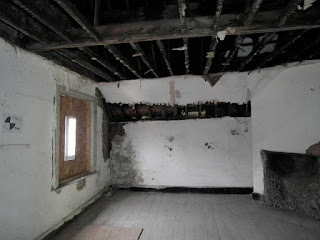 This then is Moore Street. It is at the centre of the battlefield site. “The laneways of history” according to former Taoiseach Enda Kenny.In any other state in the world such places are preserved, open to the public and are a place of pilgrimage. Ron Maxwell, a US filmmaker, describes it well. Quoted by the 1916 Relatives he says: “Battlefields are looking glasses into the world of our ancestors. Standing on their earth under their skies, is to be at one with them and to viscerally understand humanity’s connections across time. The generation that won independence lives in the ideas we honour, the architecture we preserve and the battlefields we can yet save.”But not in Dublin.14-17 Moore Street was adopted by the Irish government in 2007. Thirteen years later no work has begun. The four buildings are in a serious state of disrepair and are closed. The government ignored the recommendations from a consultative group several years ago and successfully appealed a landmark court ruling that Moore Street be preserved. It has pursued a short sighted policy which reduces the battlefield site to these four buildings. The rest are to be demolished as part of a redevelopment plan for the district.Last year the Moore Street Advisory Group submitted its ‘Special Report 2’ to the Minister for Culture. That report drew on the recommendations of the 2017 ‘Securing History – the Moore Street report’ which accepted that “there should be appropriate recognition of the history of the street and its part in the Rising”. Last year’s report called on the government to reconstitute the Moore Street Advisory Group with “representation from the Oireachtas, Dublin City Council, representatives of all of the participating groups on the present group, traders and an independent chair.” A year later and this report still sits on the Ministers shelf.
This then is Moore Street. It is at the centre of the battlefield site. “The laneways of history” according to former Taoiseach Enda Kenny.In any other state in the world such places are preserved, open to the public and are a place of pilgrimage. Ron Maxwell, a US filmmaker, describes it well. Quoted by the 1916 Relatives he says: “Battlefields are looking glasses into the world of our ancestors. Standing on their earth under their skies, is to be at one with them and to viscerally understand humanity’s connections across time. The generation that won independence lives in the ideas we honour, the architecture we preserve and the battlefields we can yet save.”But not in Dublin.14-17 Moore Street was adopted by the Irish government in 2007. Thirteen years later no work has begun. The four buildings are in a serious state of disrepair and are closed. The government ignored the recommendations from a consultative group several years ago and successfully appealed a landmark court ruling that Moore Street be preserved. It has pursued a short sighted policy which reduces the battlefield site to these four buildings. The rest are to be demolished as part of a redevelopment plan for the district.Last year the Moore Street Advisory Group submitted its ‘Special Report 2’ to the Minister for Culture. That report drew on the recommendations of the 2017 ‘Securing History – the Moore Street report’ which accepted that “there should be appropriate recognition of the history of the street and its part in the Rising”. Last year’s report called on the government to reconstitute the Moore Street Advisory Group with “representation from the Oireachtas, Dublin City Council, representatives of all of the participating groups on the present group, traders and an independent chair.” A year later and this report still sits on the Ministers shelf.
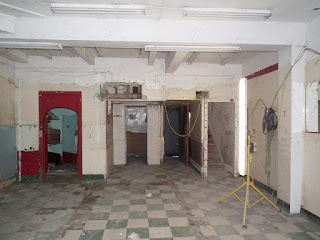 In the meantime we now also know that an archaeology report for Courtney Deery Heritage Consultancy revealed that ‘middens’ or refuse dumps going back several hundred years were found behind 15 and 16 Moore Street. The report concludes that; “The houses and the material assemblage are ordinary and commonplace which through happenstance and historic events has elevated their significance to national importance... “ A second report by Kelly Colgan Architects recommends that nos 10 Moore Street “is of Architectural, Cultural and Social ‘Special Interest’” and should be protected. The same report also identifies numbers 20 and 21 as buildings of “Architectural, Cultural and Social ‘Special Interest.” And finally this report recommends that “O’Brien’s Bottling Stores is of Architectural, Cultural and Social ‘Special Interest” and that it too is protected.Last month there was a fire at number 9 Moore Street which took three fire engines two hours to bring under control. The relatives of the 1916 Leaders are concerned that this will not be the last fire and that without significant and speedy progress there is a real danger to all of these remarkable buildings. Thirteen years after 14-17 Moore Street were designated as a national monument and after years of campaigning the government continues to resist protecting the battlefield site. What the British Army and its shelling of Dublin 104 years ago failed to achieve this government looks likely to succeed in destroying most of what the National Museum has described as “the most important historic site in modern Irish history.”So why does the government refuse to develop this site as a historic quarter which would be of huge educational, economic and social significance to the people of the Inner city, the capital and the nation, as well as a fitting memorial to the heroism of the men and women of 1916?Call me stupid but I don’t think it’s just because the state and the establishment are uncomfortable with the events of 1916 or their refusal to live up to the commitments of the Proclamation. That’s undoubtedly part of it. But it’s also because the vested interests, big business and the developers involved see this battlefield site as a potential source of great wealth for them. It’s all about corporate greed. In many ways the story of Moore Street is a metaphor for the state we are in. If you want to save Moore Street write to An Taoiseach at leo.varadkar @oir.ie or The Dept of An Taoiseach Merrion Street. BAC 2
In the meantime we now also know that an archaeology report for Courtney Deery Heritage Consultancy revealed that ‘middens’ or refuse dumps going back several hundred years were found behind 15 and 16 Moore Street. The report concludes that; “The houses and the material assemblage are ordinary and commonplace which through happenstance and historic events has elevated their significance to national importance... “ A second report by Kelly Colgan Architects recommends that nos 10 Moore Street “is of Architectural, Cultural and Social ‘Special Interest’” and should be protected. The same report also identifies numbers 20 and 21 as buildings of “Architectural, Cultural and Social ‘Special Interest.” And finally this report recommends that “O’Brien’s Bottling Stores is of Architectural, Cultural and Social ‘Special Interest” and that it too is protected.Last month there was a fire at number 9 Moore Street which took three fire engines two hours to bring under control. The relatives of the 1916 Leaders are concerned that this will not be the last fire and that without significant and speedy progress there is a real danger to all of these remarkable buildings. Thirteen years after 14-17 Moore Street were designated as a national monument and after years of campaigning the government continues to resist protecting the battlefield site. What the British Army and its shelling of Dublin 104 years ago failed to achieve this government looks likely to succeed in destroying most of what the National Museum has described as “the most important historic site in modern Irish history.”So why does the government refuse to develop this site as a historic quarter which would be of huge educational, economic and social significance to the people of the Inner city, the capital and the nation, as well as a fitting memorial to the heroism of the men and women of 1916?Call me stupid but I don’t think it’s just because the state and the establishment are uncomfortable with the events of 1916 or their refusal to live up to the commitments of the Proclamation. That’s undoubtedly part of it. But it’s also because the vested interests, big business and the developers involved see this battlefield site as a potential source of great wealth for them. It’s all about corporate greed. In many ways the story of Moore Street is a metaphor for the state we are in. If you want to save Moore Street write to An Taoiseach at leo.varadkar @oir.ie or The Dept of An Taoiseach Merrion Street. BAC 2
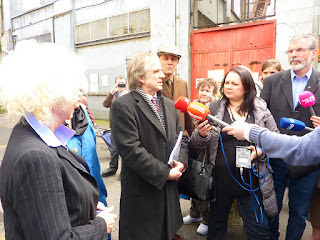 James Connolly Heron and Patrick Coney speaking to the media in Moore Land
James Connolly Heron and Patrick Coney speaking to the media in Moore Land
Published on April 17, 2020 07:50
April 10, 2020
Easter and The New Republic; and Songs to be Sung
There probably has not been an Easter week quite like this one in modern Irish history. I have always liked Easter and although I have less connection now with the institution of the Catholic Church, Good Friday always is a special day for me. It is the one afternoon that I try to slip into a church to reflect on the life of Jesus and his execution by crucifixion all those years ago. This Good Friday the churches are closed. In fairness a church is not necessary for reflection. Any quiet place will do. But it will be strange nonetheless.
For those of us who commemorate the 1916 Easter Rising this will be a strange year also. There were Easters when repression and imprisonment, north and south, resulted in only a handful of activists coming together at gravesides and republican memorials to lay a wreath, read the Proclamation and list the names of our Patriot Dead. These were the Easters when successive Irish and Unionist governments banned such remembrances and used brutal tactics to enforce that ban. During the more recent years of conflict some Easter commemorations and republican memorials and graves were also bombed and damaged.
This Easter we face a different kind of adversary. A silent, deadly enemy - the Coronavirus. So the traditional Easter Commemorations have been cancelled.But that doesn’t mean that republicans will not commemorate our patriot dead. On the contrary this year commemorations will be more personal, more intimate as we as individuals and as families participate in our own little commemorative events or join in the online programme devised by Sinn Féin and others during this unprecedented health emergency. This includes a programme of social media events and posts, videos - some historical, speeches, including the keynote Easter address by Party President Mary Lou McDonald TD, music, encouraging children to produce art work reflecting on Easter, poetry, the flying of our national flag and the wearing of the Easter Lily.
Many of us have favourite rebel songs and poems of struggle about the many different periods of rebellion in Ireland from 1798, through Robert Emmet, the Young Irelanders, the Fenians, to Easter 1916 and the Tan and Civil Wars, to the more recent decades of conflict. So as more and more people put video messages on social media why not consider posting your favourite rebel song? Or sing it yourself? But only if you’ve the voice for it. That leaves you out RG. Brón orm chara.
Or pick a poem by Pearse or Connolly or Bobby Sands or the last words of republican heroes. If you are a relative or friend or admirer of one of our patriot dead consider putting up a photo and telling their story.
The book ‘Last Words’ by Piaras F. MacLochlainn is a personal favourite. It contains the letters and statements of the leaders who were executed after the 1916 Rising. The poems of Pearse and the defiant statement by James Connolly to his Court Martial are often quoted but I have always had a special grá for Tom Clarke. He spent 15 years in English prisons in the 1880s and 90s and endured long years of solitary confinement during which he was treated appallingly. In 1916 he was the first signatory of the seven who signed the Proclamation. In the early hours of 3 May his wife Kathleen, who was a prisoner in Dublin Castle, was brought to visit him in his cell under military escort. With a candle held by a British soldier for light and just hours before his execution Thomas Clarke gave Kathleen a message for the Irish people. It was brief but poignant.“I and my fellow-signatories believe we have struck the first successful blow for freedom. The next blow, which we have no doubt Ireland will strike, will win through. In this belief we die happy.”
The story of the love of Joseph Plunkett and Grace Gifford is well known. ‘Last Words’ contains a letter from Plunkett to Grace on 2 May in which he writes:“Listen – if I live it might be possible to get the Church to marry us by proxy – there is such a thing but it is very difficult I am told. Father Sherwin might be able to do it. You know how I love you. That is all I have time to say. I know you love me and so I am very happy.”
At 8pm on the evening of 3 May Grace was brought to the prison chapel. Joseph entered accompanied by a party of soldiers with fixed bayonets. The soldiers remained while Fr. Eugene McCarthy read the marriage service by the light of a candle. After the ceremony they had to separate. A few hours later in the early hours of 4 May Grace was brought back to the prison and met her husband in his cell. They had ten minutes. Plunkett was executed on the morning of 4 May along with Edward Daly, Willie Pearse, and Michael O’Hanrahan.Oh Grace just hold me in your arms and let this moment lingerThey'll take me out at dawn and I will dieWith all my love I place this wedding ring upon your fingerThere won't be time to share our love for we must say goodbye
A century ago this November Kevin Barry was executed in Mountjoy Prison in Dublin. The song, which commemorates this young 18 year old, is a firm favourite with many. It has never lost its ability to stir the heart and remind us of the courage of this young man and his comrades. It has been recorded and sung countless times over the years, including by Paul Robeson and Leonard Cohen. Robeson’s version can be found at https://www.youtube.com/watch?v=BSjO9rIwn5M
In an earlier generation the essays and poems of Thomas Davis reminded people of the 1798 Rising and of the awful impact of British colonialism on Ireland. RG has an edition of a book – Essays and Poems: Thomas Davis - published by the Gresham Publishing Company sometime around the 1890s. Davis died at the age of 31 from Scarlett Fever in 1845 the first year of An Gorta Mór. One of his enduring works is “A Nation Once Again”.“And then I prayed I yet might seeOur fetters rent in twain,And Ireland, long a province beA Nation Once Again.”
Davis also wrote “The West’s Asleep” which in more recent years has been made famous by the Dubliners https://www.youtube.com/watch?v=ZXCT3LwL2Go and the Clancy Brothers and others as “The West’s Awake.
So, this week and next use social media to post a personal reflection of the events in Dublin and elsewhere in 1916 and of all those periods of struggle in Ireland’s long history of resistance and our demand for freedom. It can be something from youtube or it can be you and those in your home or you and your friends singing, reciting, reading about Ireland’s patriot dead.
These are some of my personal words and poems and lyrics. Enjoy:Óró 'Sé Do Bheatha Abhaile : https://www.youtube.com/watch?v=WwM8pCAynbM Boulavogue, The Flying Column: https://www.youtube.com/watch?v=uv4ifmS7H20 Four Green Fields: The Flying Column: https://www.youtube.com/watch?v=3TuEkwktb9EFor What Died The Sons Of Róisín: Luke Kelly : https://www.youtube.com/watch?v=C14U7JYGRgA A Song for Ireland: https://www.youtube.com/watch?v=WwpEDYXAbJgThe Foggy Dew The Chieftans and Sinead O’Connor : https://www.youtube.com/watch?v=yaS3vaNUYgs Johnston’s Motor Car ; https://www.youtube.com/watch?v=GonUTdh7VBI The Boys of Wexford : https://www.youtube.com/watch?v=SmBTjeowz4k Come out ye Black and Tans ; The Wolfe Tones ; https://www.youtube.com/watch?v=ORifieiZiP4 Henry Joy ; Tommy Makem ; https://www.youtube.com/watch?v=x4uu63jSp0k Mise Éire Seán Ó Riada ; https://www.youtube.com/watch?v=CbkUTDKZC3sBack Home in Derry; Bobby Sands/Christy Moore ; https://www.youtube.com/watch?v=c5_wZmTHfo8Legal Illegal ; Frances Black : https://www.youtube.com/watch?v=AkHwkRfsqBQMná na hÉireann ; Seán Ó Riada ; https://www.youtube.com/watch?v=6HBP1ACekwQ
Have a great Easter. Wear An Easter Lily. Sinn Fein will be putting up a link to a site where you can download a Lily.
It is also my intention to start posting a regular podcast based on the blogs.The first went up yesterday. Its available on all platforms.
Remember those we commemorate and the Proclamation of the Republic in 1916, are all about the future. That’s what we struggle for. It’s what we look forward to. The New Republic.
Published on April 10, 2020 06:59
April 2, 2020
A CHANGE HAS GOTTA COME
All of us are adjusting to our new routines and trying to come to terms with the real threat posed by the Corona Virus pandemic. The thousands of deaths in Italy and Spain are grim reminders of what may be coming our way and a deadly incentive for us all to stop close contact with other human beings and to keep to the health directives which now govern how we live. It would be easy to be overwhelmed by all this. We all know someone who has the virus. We know we could be next. So we watch the responses of those in the three governments which rule us as we wait for the next news report or the next instruction.
Don’t make this political some readers may say. Why not? It is political. I don’t want decisions about the well being of my family and friends to be made by a Jack the Lad in London who has vandalised the very health services which we are so dependent on. Neither do I want a caretaker Taoiseach without a mandate who did exactly the same thing when he was in power. Or his partner the Fianna Fáil Leader who did the same thing. I can just about put up with the novel form of governance which we tolerate in the North because of our peculiar circumstances but I want change. Not footery, fiddley cosmetic change. Not spin. No! I want real societal change. That includes a real public health service alongside other public services.
If ever there was a need for decent health services, properly resourced and funded, this pandemic has provided the evidence for it. It has also demonstrated the folly of partition with its two health and economic systems on our small island. Add to this a decade of austerity policies by the Tories in London and by Fine Gael, Fianna Fáil, the Greens and Labour in Dublin and you have health systems already unable to meet the normal needs of citizens. Faced with a pandemic virus, which has required an unprecedented societal response, our two health systems have been fighting a desperate battle to provide the necessary health care to the growing numbers of citizens succumbing to Covid-19.
Last week along with millions of others across these islands I applauded the courage and selflessness of health service staff who are putting their lives on the line against an insidious viral enemy. Like most of you I know family members, neighbours, friends who go to work every day within our health system. They don’t see themselves as heroes. But that is who they are. Heroes, who deserve our solidarity and our thanks. They also deserve personal protection equipment that is fit for purpose and intensive care units and ventilators sufficient to meet the needs of their patients.
It is a fact that the Health Service in the North has always been underfunded. This has grown worse in the last decade under British conservative governments, supported by Unionist parties. As a result waiting lists have lengthened, and accident and emergency departments are under resourced.
In the South the two tier health service created and funded by successive Fine Gael, Fianna Fáil and Labour governments, and the austerity policies of these parties, created enormous gaps in health care provision. Acute hospital beds were cut, a moratorium on hiring nurses and health staff was imposed, and investment in the health service was slashed. Beds in Intensive Care Units were dramatically cut.
According to the World Health Organisation, the Irish state is “unique among EU countries in not providing universal coverage of primary care ... its system of entitlement to publicly financed healthcare is complex”. WHO concluded that: “This results in not only unmet need but also inequitable and inefficient patterns of use ... These barriers are substantial relative to other EU countries, especially for primary care.”
The OECD has made an equally damning assessment of the British health system.
The decision therefore by the government in Dublin to take control of private hospitals was belated but welcome. It would also be interesting to see the small print of that agreement. But it is only for the duration of this emergency. After the crisis is over the government’s ideological stance will return us to the status quo - a two tier health service in which patients must pay for access to GPs and receive bills for treatment in A&E departments.
It is this same ideological position that caused Fine Gael, Fianna Fail and Labour’s failure to invest in public services. The Director General of the Irish Business and Employers Confederation (IBEC) acknowledged this last November. He cited as evidence the ongoing crises in housing and homelessness, the scandal of a health service, as well as deficiencies in childcare provision, public transport and education.
All of this led to a widespread public desire for change. This became evident in February when Sinn Féin emerged as the largest party in the state in the general election. The Coronavirus crisis has amplified this demand for change. It is now a constant and growing refrain on social media platforms, and in newspaper articles and opinion pieces. How often have you heard or read it said that things can never be the same again. That there must be change. That we can’t simply continue as before. That we have to change the way we do our politics. That this global crisis must lead to fundamental societal change - economic, social, health and political change.
Political decisions needed to protect families, secure jobs for the future, maintain a reasonable level of income have been forced on reluctant governments in Dublin and London.
Note however that the bankers and insurance companies continue to rip off citizens. Note how those most likely to succumb to the virus are the elderly, the vulnerable, the poor, the homeless. citizens in Direct Provision, in nursing homes, in Traveller sites and frontline health workers.
There is a real danger that out of these hard times we will see the old order re-invent itself. Fine Gael and Fianna Fáil in government is not change. Remember how in the aftermath of the 2016 general election there was much talk of ‘new politics,’ of a new way of doing things. Editorial and opinion writers and many political commentators wrote reams about the transformation heralded by this ‘new politics’. But thankfully citizens saw through this. It was all a scam – it was all a lie. The ‘confidence and supply’ arrangement between Fine Gael and Fianna Fail was coalition by another name.A Fine Gael – Fianna Fáil carve up coalition will just be more of the same. The spin will be different but the core conservative politics will remain unchanged.
So too in the North for as long as we are tied to Britain.
Irish republicans have a different vision of the future from the establishment parties. We are for a national republic – a new Republic. But we dont have to wait until then to make change . We can insist here and NOW on the highest standard of services and protections for all citizens equally. We can demand parity of esteem and equality of treatment, opportunity and outcome. Thats what the Good Friday Agreement sets out.
In the here and now we should all be demanding real change which benefits citizens, protects working families, takes care of the disadvantaged, and invests in public services. That’s what citizens deserve. But that will only happen if we make it happen.
This is not pie in the sky. This is doable. Society on this island is already shifting. Changing demographics and political allegiances, new ideas and concepts, new leaderships are reshaping Ireland today. Let’s not allow the self-interests of the old conservative parties to dictate the limits of our potential or of our future. Let us argue for a real National Health Service across the island of Ireland with seamless and maximum co operation between both parts.
As we face into whatever distress and tragedy the pandemic serves up let us resolve that our health workers and carers will never again have to beg or borrow protective clothing. Let us resolve that our nurses will be properly paid and that there will be enough of them. Let us resolve that our doctors and patients deserve the best facilities. Let us resolve that our elderly and vulnerable citizens will have their rights. Let us resolve that heath service is one of these rights. It is not a business or a privilege.
And let us resolve that the best people to take these decisions for the people of this island are the people of this island. Not some Jack the Lad in London.
Published on April 02, 2020 05:16
March 26, 2020
UP THE REBELS.
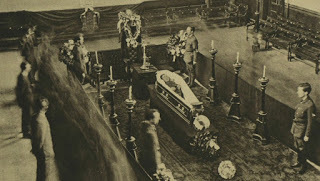 Tomás MacCurtain lying in state 100 years ago
Tomás MacCurtain lying in state 100 years ago
The necessary cancellation of Easter Rising Commemorations does not mean we should not celebrate these events. We can all wear an Easter Lily. Wherever possible wreaths can still be laid, Proclamations read, a moments silence observed. All this can be done by one or two people while keeping social distance. No need for big crowds. No need even to leave our homes. Find a quiet space. Remember fallen comrades. Read a Pearse or MacDonagh poem to yourself. Sing or play a patriotic song. Reflect on the lives, the work, the courage of the men and women of 1916 and those who followed their example since then. Reflect on the past. Plan for the future.
Back in the day Easter Commemorations were banned by the old order in Belfast and Dublin. But intrepid republicans usually found a way to break the ban. Some even went to gaol for doing so. Back in the day in punishment cells or lockup, as political prisoners, separated from other incarcerated comrades, we would pay our own individual homage to the past and the future. On our ownie-ohs in a bare prison cell. Alone. But together. Separated. But united.In the last eight years of the ‘Decade of Centenaries’ there have been many innovative, emotional, often inspiring, frequently exuberant, and poignant commemorations across the island of Ireland and beyond. For me one of the most memorable and goosebump moments occurred on a crisp Easter Sunday morning in 2016. Thousands came to the Sinn Féin commemoration outside the GPO in Dublin. In one unforgettable moment they spontaneously raised their voices acappella. It started like a whisper and grew in defiant harmony as the echo of the song swelled up to fill O’Connell Street as proud rebels joyously sang ...“A Nation once again, A Nation once again, And Ireland, long a province, be A Nation once again!”A Nation once again, A Nation once again, And Ireland, long a province, be A Nation once again!”All of these commemorations marked events that took place in the upheaval that shook Ireland a century ago. The signing of the Ulster Covenant; the Dublin Lock-out; the formation of the Irish Citizen’s Army, the Irish Volunteers and Cumann na mBán; gun-running by the UVF and Irish Volunteers; the 1916 Easter Rising, The Proclamation and the execution of the leaders; the 1918 election; the establishment of the First Dáil in January 1919 and more.Many of these were organised by local communities proud of their history.1920 - a century ago- was an especially important year. For many it was the tipping point for much that has occurred since. It was a year in which the IRA demonstrated to the British government that resistance to British rule was no short term aberration but a popular struggle for change that could not be militarily defeated. Most of Trim in County Meath was destroyed by the RIC and Black and Tans; so was Balbriggan and Cork city. Little wonder patriotic citizens were outraged by the Irish governments intention recently to honour these forces.In December 1920 the British passed the Government of Ireland Act which imposed partition and established two states on our island.Two of Corks Lord Mayors died in the cause. Last Friday - March 20 - was the anniversary of one of these - the murder of the Rebel City’s first Sinn Féin Lord Mayor Tomás MacCurtain. He had been elected to the position of Mayor after the local government elections on 15 January 1920. That election, following on from the 1918 election, saw significant gains for Sinn Féin. The January elections were for urban and district Councils. Sinn Féin and Labour candidates and other nationalists won 172 of the island’s 206 Councils. Later in June Sinn Féin won 338 out of 393 local government bodies, including 36 rural districts out of 55 in Ulster. One consequence of this was that unionists moved quickly to introduce a major gerrymandering of council boundaries in the six counties. They ended the PR system of election, and introduced property qualifications for the vote which left tens of thousands of nationalists with no franchise in local government elections.At his election as Lord Mayor of Cork on January 31, Tomás MacCurtain pledged that he would stand by the principles of the Republic declared at Easter 1916 and to promote Irish freedom. He proposed that the Council give its allegiance to Dáil Éireann. He believed that local authorities were key to the success of the First Dáil. He said: “it was up to local bodies now to pledge their allegiance to the government set up by the representatives of the people – to pledge their allegiance to Dáil Éireann.” He then raised the tricolour over Cork City Hall. MacCurtain’s election was greeted with loud applause and a rendition of Amhrán na bhFiann – A Soldier’s Song - which at that time was generally referred to by the public as the Sinn Féin song.As well as being Lord Mayor MacCurtain was also Commanding Officer of the Cork No 1 Brigade of the IRA. He was very popular, a teacher of Irish, an advocate of the Gaelic League, and a diligent public representative.As a young man MacCurtain had travelled the roads and lanes of rural Munster promoting the Gaelic League and teaching classes in Irish. Later he travelled the same roads promoting and organising the Irish Volunteers in Cork. After the 1916 Rising he was interned. On his release and following the commencement of the Tan War MacCurtain emerged as a popular leader in the IRA.In the early hours of March 20th 1920 – MacCurtain’s 36th birthday – armed RIC men with blackened faces led by Inspector Oswald Swanzy forced their way into his home. It had been raided over 20 times in previous months. His wife Eilís later said that “they seemed to know the house better than I did.” Two men ran upstairs to his bedroom. As Tomás MacCurtain opened the bedroom door he was shot twice in the chest. A third shot was also fired. He fell to the floor in front of his family. An hour later, as the family were kneeling by his bed, British soldiers arrived and searched the house, including the bed on which MacCurtain’s body lay.His murder sparked outrage and was widely condemned. Tomás MacCurtain’s body, dressed in his Irish Volunteer uniform, was brought to Cork to lie in state in Cork Cathedral. The funeral cortege was said to have been the biggest ever seen in the city.On 17 April 1920, a coroner’s inquest was held into the death of Mac Curtain. The jury returned a verdict of murder against RIC DI Oswald Swanzy, British Prime Minister, David Lloyd George, The Lord Lieutenant of Ireland John French, Viscount French, and the Inspector General of The Royal Irish Constabulary T.J. Smith.The British, in an effort to protect Swanzy from IRA reprisals, transferred Swanzy from Cork to Lisburn.Volunteers of the First Battalion, Cork No. 1 Brigade went there to kill him. They did so on 22 August, as Swanzy was leaving Christ Church Cathedral, Market Square, Lisburn.It is widely believed that Mac Curtain’s personal handgun was used to kill Swanzy.Catholic residential areas of Lisburn were burned in revenge by loyalists. Several people were later prosecuted for the burnings. Loyalists attacked Catholic areas of Belfast. A total of 33 people died over the next ten days in sectarian rioting and shooting in the city.Tomás MacCurtain was the first of two Cork Lord Mayor’s to die that year. Seven months later, in October 1920, MacCurtain’s friend and comrade Terence MacSwiney died in Brixton prison after 73 days on hunger strike. MacSwiney, who replaced Tomás MacCurtain as Lord Mayor after his murder, gave the oration at his funeral. He said that although MacCurtain’s life’s work had been interrupted the fight for freedom would carry on.
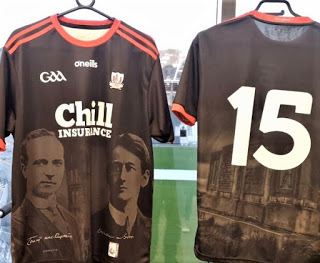
This year as part of a programme of events to mark the 1920 centenary in Cork the GAA produced special commemorative jerseys for its senior footballers and hurlers. This is an innovative way to honour our history. Fair play to those involved. The gansaí front has an image of Tomás MacCurtain on the left and Terence MacSwiney on the right, with Cork burning as the backdrop. The back of the jersey has an image of the commemorative stone at Kilmichael which marks the ambush in November 1920 of a force of British auxiliaries. It was the biggest engagement of the Tan War and saw 16 auxiliaries killed and three IRA volunteers die.Thankfully those days of conflict, including in our own time, are over. But we should not be reticent about remembering them. We should do so respectfully and in a tolerant way. Revisionists should be challenged intelligently and robustly. There is now a peaceful way to win freedom. But it was not always the case. So whatever freedom we have or will have in the time ahead we should never forget the pivotal role of rebels in that cause.Easter is now only two weeks away. The Coronavirus crisis means that this year there will be none of the big public displays of Republican solidarity with our fallen comrades and their families.So lets find innovative and imaginative ways to remember them, even on our own. Let’s post our contributions on social media. Let’s celebrate the 1916 Rising and the struggle for freedom. Let’s honour our past and plan for the future. Alone if need be. But together. Separate. But United.
Published on March 26, 2020 07:31
Gerry Adams's Blog
- Gerry Adams's profile
- 29 followers
Gerry Adams isn't a Goodreads Author
(yet),
but they
do have a blog,
so here are some recent posts imported from
their feed.



